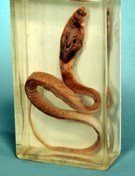
Cobra


Classification
- Kingdom - Animalia
- Phylum - Chordata
- Sub Phylum - Vertebrata
- Class - Reptilia
- Order - Squamata
- Family - Elapidae
- Genus - Naja
- Species - N. naja
- Body is long and cylindrical. Head is flattened and distinct from the body.
- In generally they are feed on rodents, toads, frogs, birds and other snakes. Its dietary pattern leads it to areas inhabitant by humans including farmlands and out skirts of urban areas.
- In Hindu culture cobra also worships as a very powerful deity. On the other hand the cobra is connected with God Shiva, who is a major God character in Hindu culture. This also leads the cobra as a powerful deity in Hindu culture.
- Coloring of the cobra varies black to dark brown to cream white.
- Average size of the cobra is about 6 feet in length and rarely as long as 8 feet.
- The most distinctive and impressive characteristic of the snake is the hood. It forms by raising the anterior portion of the body and spreading some of its ribs in the neck region, when it’s tempered.
- On the rear of the snake hood are two circular ocelli patterns connected by a curved line evoking the image of spectacles. This image resembling the letter “Pa” in Sinhala alphabet, which cause that the snake called “Payanu Naya” in folklore in Sri Lanka.
- The most characteristic feature it is the wide black band on the underside of the neck.
- The cobra laid eggs between April and July. Female snake usually lays 10-30 eggs in rat holes or termite mounts.
- The eggs are hatch about 50 days later, the hatchlings measure around 20-30 cm in length.
- They are independent from the birth and have fully functional venom glands.
- One of the highly venomous snakes in Sri Lanka.
- Also this is the only one serpent in Sri Lanka with a hood.









